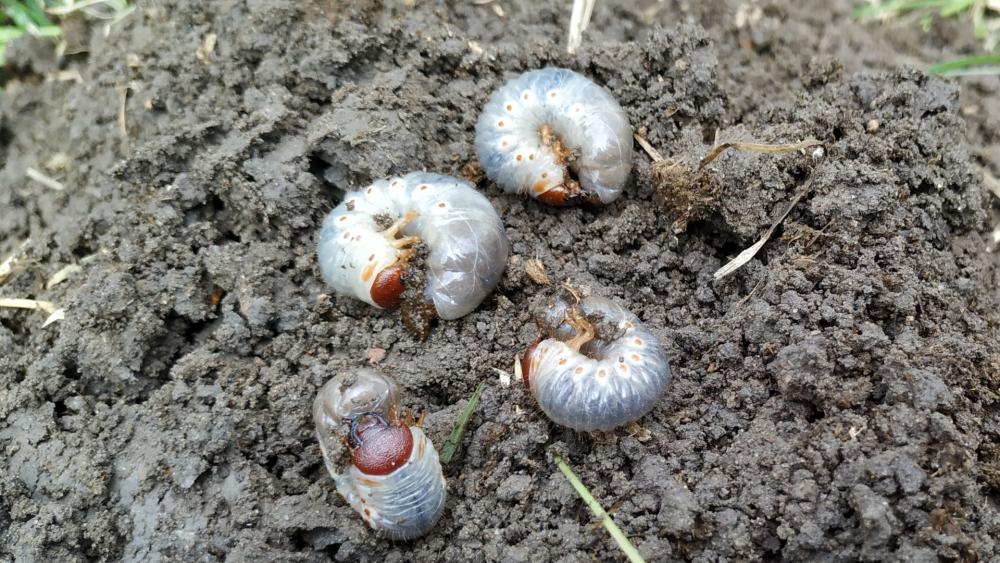Learn About What Causes Grubs And How To Control Them
If you have been experiencing strange, unexplained brown patches in your lawn, it is possible that you have a grub infestation. What are grubs? What causes grubs in your lawn? How can you get rid of them and prevent future problems?
In this blog post, we will answer all of these questions and more!
What Are Grubs?
Grubs are the simply larval stage of certain beetles, including European chafer, June beetles, and Japanese beetles. They are white, C-shaped creatures that feed on the roots of grasses and other plants. There are some beneficial insects for your lawn, but grubs are decidedly not one of them, especially in numbers. While a few grubs in your yard may not cause significant lawn damage, large numbers can kill grass and make it more difficult for new seedlings to take root.
They feed on the roots of grasses, making them a major pest to lawns and turf. In addition to causing cosmetic damage to your property, grubs can make it more susceptible to drought and disease. As a result, grubs can be a serious problem for homeowners and gardeners alike.

Grubs are usually translucent or white with a reddish brown head.
How To Identify Grubs
One of the telltale signs of grubs in your lawn is grass that appears to be growing less vigorously. The grass doesn't grow well or seems to be browning and dying in patches. This is often because grubs feed on grass roots, which can stunt the growth of your lawn.
Another way to tell if your yard has grubs is by looking for tiny, white larvae in the soil. These larvae are the grubs themselves, and they are usually the offspring of beetles that have laid their eggs in your lawn. If you suspect your property has a grub problem, you can confirm it by digging up a small section of grass and soil.
How To Inspect For Grubs
One way to inspect for grubs is to look for areas of dead or dying grass. Grubs cause the grass to die by feeding on the roots, so affected areas will typically have patches of brown or yellow grass. Homeowners should also look for grubs themselves. They are small, white, and curl up into a C-shape when disturbed.
To get an estimate of the size of the grub problem, homeowners can measure, dig up, and peel back a square foot of affected turf and count the number of grubs present. If there are more than about ten grubs per square foot, this is indicative of a grub problem that needs to be addressed.

More than 10 grubs per square foot means you likely have a grub problem.
What Causes Grubs In Your Lawn?
White grubs are the offspring of various moths and beetles who lay their eggs in your lawn's soil. During the winter, they will spend their entire life underground, where they are protected from the cold by a few inches of soil. One common misconception is that the mere presence of grubs is automatically a bad thing. Under normal circumstances, and when a grub population is low, they are a normal part of having a lawn.
However, when their population grows too large and dense, your lawn will see visible problems such as dying grass. You may even spot holes in your yard from birds and other predators attempting to find and eat the grubs.
If your lawn has rich soil, is well-aerated, and is generally healthy, this is the perfect environment for grubs. It's also a healthy-looking yard.
Take Care With Over-watering
If you over-water your lawn during the summer, you may be providing excess moisture for the grubs to thrive in. The longer you water, the more likely that moisture is to seep down into the layer of soil where they reside.
Mow Your Grass Higher
Generally, the longer your grass is, the deeper its roots are. Therefore, grass that has deeper, stronger roots is less likely to be susceptible to grub damage. Conversely, shallow grass roots allow grubs to eat and damage your grass roots more thoroughly.

Grubs often thrive in healthy lawns, but you can reduce their numbers by mowing higher and taking care not to over-water.
Grub Control: How Do You Get Rid Of Grubs Fast?
Unlike some other pests around the home, grubs are straightforward to get rid of. However, the timing is critical when it comes to getting rid of them effectively and quickly.
To quickly and efficiently kill grubs, you'll want to apply grub control while they are still in the relatively early stages of their annual development cycle. This usually occurs in late summer, and the grubs will continue to grow larger throughout the fall.
Grub Prevention And Grub Control Products
Much of grub prevention has to do with simply keeping the grubs from developing in your lawn. If you can prevent their hatch, or their development, the cycle of them damaging your lawn will decrease dramatically.
While several options are available, like beneficial nematodes and powder that spreads milky spore disease among the grubs, we highly recommend Imidacloprid .5G Granular Insecticide. It is one of the most effective products available for grubs.
To kill grubs quickly, you'll spread the Imidacloprid over your yard, preferably during insect egg-laying activity. This insecticide also works after the grubs have hatched but is more effective when the grubs are smaller and weaker. Additionally, if you suspect heavy rainfall or have a sprinkler system set up, the Imidacloprid will absorb into the soil better when the ground is wet.
We encourage you to check out our online lawn & garden learning center for more information on lawn care, beetles, grubs, and much more on pest control!









